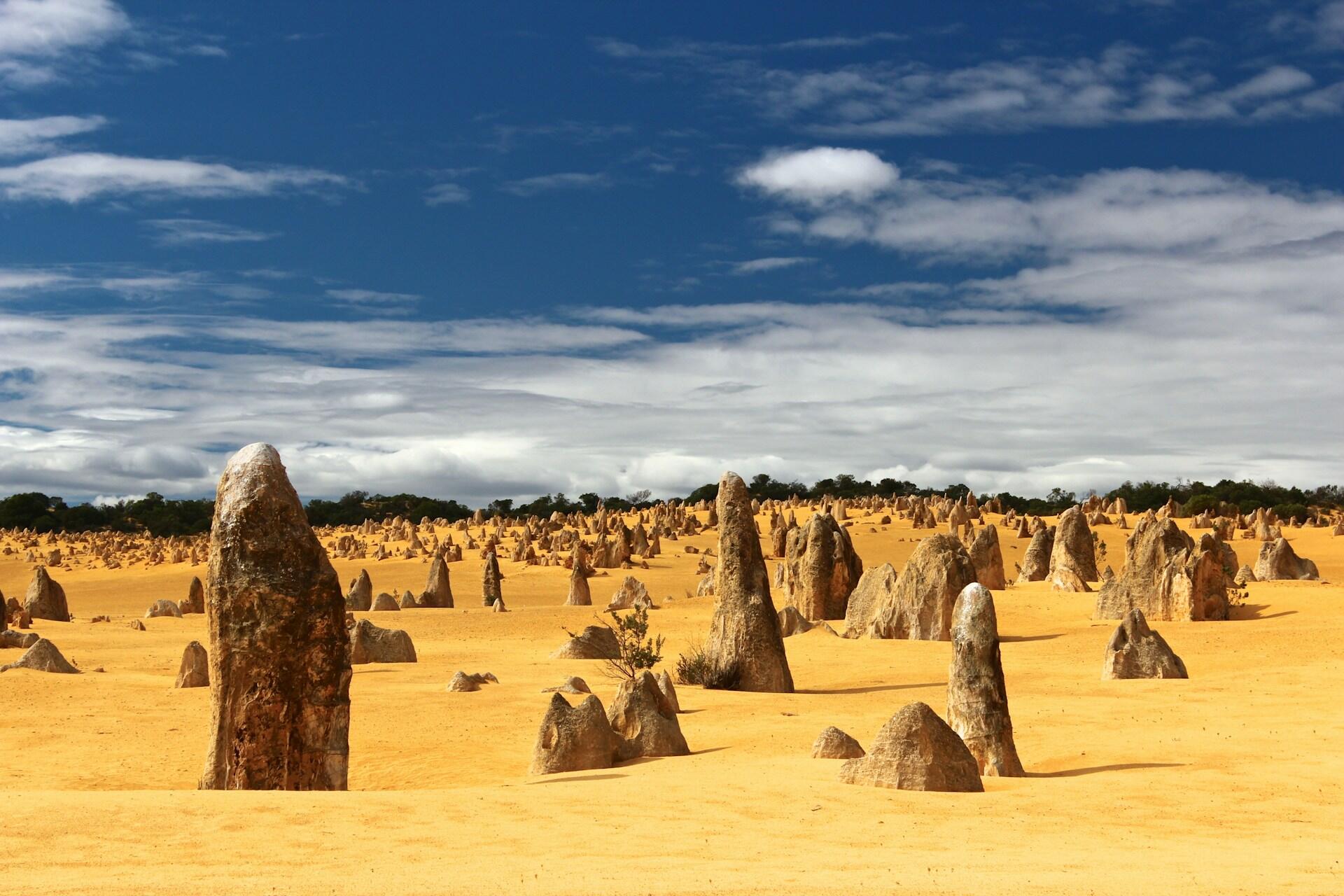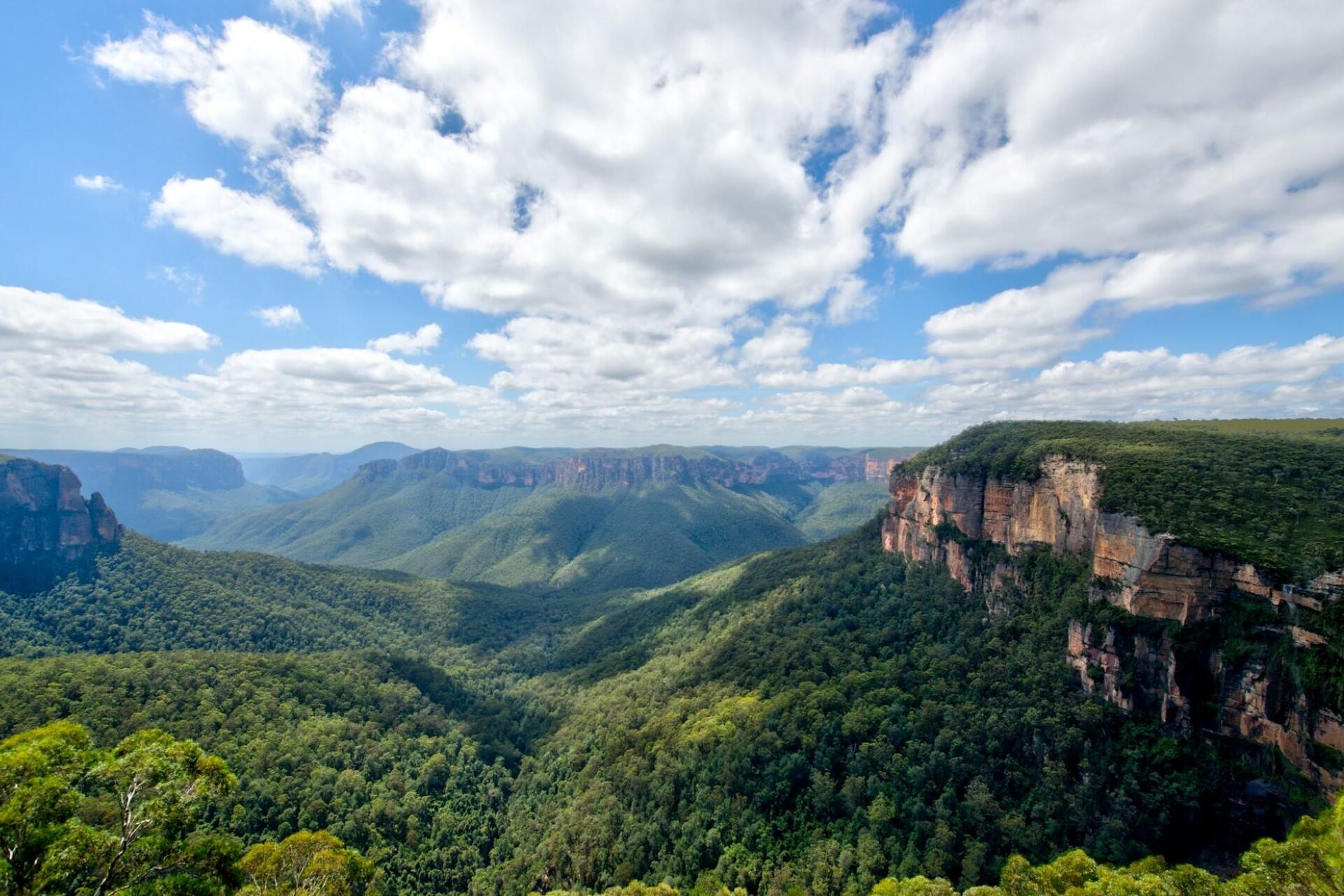Australia is a continent of extremes. Tropical in the North with snowy southern mountain ranges. It experiences plenty of different climates. Let's explore Australia's various climate zones, seasons, and extreme weather.
| Region | Climate Zone | Average Summer Temperature (°C) | Average Winter Temperature (°C) | Annual Rainfall (mm) | Key Characteristics |
|---|---|---|---|---|---|
| Northern Australia (Darwin, Cairns, Broome) | Tropical | 30–34 (high humidity) | 20–25 (dry, mild) | 1,200–2,000 | Wet and dry seasons; tropical monsoons and cyclones; lush vegetation year-round. |
| Eastern Coast (Brisbane, Sydney, Coffs Harbour) | Subtropical to Temperate | 26–32 | 10–18 | 800–1,500 | Warm, humid summers and mild winters; regular coastal rainfall and high sunshine. |
| Central Australia (Alice Springs, Uluru) | Desert (Arid) | 35–45 (daytime) | 5–20 (nighttime) | <250 | Hot, dry, and clear; extreme temperature swings; sparse vegetation and drought-prone. |
| Southern Australia (Melbourne, Adelaide, Perth) | Temperate | 25–33 | 8–16 | 400–800 | Warm to hot summers, cool winters; Mediterranean influence with winter rainfall. |
| Tasmania | Cool Temperate | 20–25 | 5–12 | 600–1,200 | Coolest state; wet, cloudy winters; lush forests and fertile farmlands. |
| Australian Alps (Mount Hotham, Charlotte Pass) | Alpine | 10–20 (summer) | −5–5 (winter) | 1,000–2,000 (snowfall included) | Coldest region; regular winter snow; alpine vegetation and ski resorts. |
| Western Interior (Kalgoorlie, Great Victoria Desert) | Semi-Arid | 30–40 | 10–18 | 200–400 | Hot, dry, low rainfall; transition between desert and coastal climates. |
| Southwest Coast (Margaret River, Albany) | Mediterranean | 25–30 | 7–15 | 700–1,200 | Dry, warm summers; cool, wet winters; strong winds and fertile soils. |

What Is the Climate in Australia?
Australia's climate is one of the world's most varied. It features everything from tropical rainforests in the North and temperate coasts to alpine regions in the south and even deserts and snowy mountains. The reason for the variety is down to its position in the Southern Hemisphere and its proximity to major ocean currents.
Generally speaking, the climate in Australia is influenced by the subtropical high-pressure belt. This brings dry, sunny weather to most of the interior. The coastal regions tend to experience more moderate conditions because of their proximity to the Indian and Pacific Oceans. In the North of the country, the weather has a distinct wet and dry season, which can significantly affect Australia's rivers. In contrast, the South has four traditional seasons, more like large parts of Europe and North America.
Though Australia is famous for sunshine and heat, Australia's climate isn't hot across the board. There are tropical monsoons, arid deserts, and cool alpine zones. This is why Australia is an excellent country for various lifestyles, ecosystems, and agricultural industries¹²³.
Australia’s Climate Zones
Australia can be divided into climate zones. These are shaped by geography, latitude, and ocean influences. The Bureau of Meteorology and Geoscience Australia classify the continent's climates using the Köppen system. This is a global standard that classifies climates through variations in temperature, rainfall, and vegetation. There are six main zones in Australia: tropical, subtropical, desert (arid), semi-arid, temperate, and alpine.

This zone experiences high humidity, warm temperatures year-round, and a distinct wet and dry season. The wet season runs roughly from November to April, bringing monsoonal rains, cyclones, and lush growth. Darwin, for instance, averages 320 days of sunshine annually but also heavy rainfall in summer⁴.
Here, summers are hot and humid while winters are mild. Coastal cities such as Brisbane and Coffs Harbour enjoy a balance between rain and warmth, making it one of Australia’s most livable regions.
Covering about 35% of the continent, this zone is dominated by low rainfall, intense heat, and clear skies. Average annual rainfall can be less than 250 mm in places like Alice Springs, while daytime summer temperatures regularly exceed 40°C⁵.
Acting as a buffer between the deserts and coastal climates, semi-arid areas experience erratic rainfall and high evaporation. Seasonal variations are more noticeable here than in the true desert interior.
Characterised by moderate temperatures and reliable rainfall, this is where most Australians live. It supports rich farmlands, forests, and major cities like Melbourne, Adelaide, and Hobart.
The smallest climate zone, located in the Australian Alps, is marked by cold winters, snowfall, and occasional sub-zero temperatures. Mount Hotham and Charlotte Pass in New South Wales record some of the country’s lowest temperatures each winter⁶.
Seasons in Australia
Due to the size of Australia, the seasons don't apply uniformly across the country. Australia's position in the Southern Hemisphere means that its seasons are reversed to those in the Northern Hemisphere, which some Americans and Europeans, in particular, can find confusing. As mentioned, the south of the country enjoys four seasons, while the north is divided into just the wet and dry seasons, which can create massive lakes that often become salt pans.

Australia's Summer Temperature
Summer in Australia runs from December to February. Long days, high heat, and brilliant sunshine. That's what most foreigners think of the Australian summer. However, temperatures vary according to region, and while coastal cities have their temperatures moderated by the ocean, inland areas can face some of the highest temperatures recorded on Earth.

Australia's Winter Temperature
From June to August, Australia experiences winter. Generally, it's mild in the North, cool along the coasts, and freezing in the Alpine regions, where you can find Australia's biggest mountains. Australia is geographically diverse, so it experiences both tropical dry winters and snowy mountain conditions simultaneously.

Climate Patterns and Extreme Weather in Australia
Australia's position between the Indian and Pacific Oceans is one of the reasons that the country experiences weather extremes. Droughts, bushfires, tropical cyclones, and floods.
Climate Change and Environmental Impact in Australia
The climate in Australia is being affected by climate change. Though Australia's geography has changed since the time it had many active volcanoes, rising global temperatures have amplified the extremes and led to hotter summers, longer droughts, and more intense rainfalls. These affect everything from agriculture and energy use to wildlife and coastal communities.

Rainfall patterns, temperature ranges, and seasonal variations that differ from north to south and east to western regions mean Australia's weather and climate are as diverse as its landscapes. Some areas in the country enjoy hundreds of sunny days each year, while others support local ecosystems and agriculture with seasonal rain. The Australian climate records, from the heat of the Outback to the chill of Canberra's winter mornings, make it clear that the weather is varied. From heavy rain on the coast or dry inland winds, rainfall and temperatures have shaped life across Australia.
References
- Australian Climate Maps. Bureau of Meteorology. Retrieved October 9, 2025, from: https://www.bom.gov.au/climate/maps/averages/
- Climate Classification of Australia (Köppen). Bureau of Meteorology. Retrieved October 9, 2025, from: https://www.bom.gov.au/climate/maps/averages/climate-classification/
- Climate of Australia – Overview. Wikipedia. Retrieved October 9, 2025, from: https://en.wikipedia.org/wiki/Climate_of_Australia
- Climatic Extremes of Australia. Geoscience Australia. Retrieved October 9, 2025, from: https://www.ga.gov.au/scientific-topics/national-location-information/dimensions/climatic-extremes
- Daily Extremes. Bureau of Meteorology. Retrieved October 9, 2025, from: https://www.bom.gov.au/cgi-bin/climate/extremes/annual_extremes.cgi
- ACORN-SAT Dataset. Bureau of Meteorology. Retrieved October 9, 2025, from: https://www.bom.gov.au/climate/data/acorn-sat/
- Australian Climate Change Observations. NSW Department of Climate Change, Energy, the Environment and Water. Retrieved October 9, 2025, from: https://www.climatechange.environment.nsw.gov.au/evidence-climate-change/australian-climate-change-observations
- The State of Weather and Climate Extremes 2021. ARC Centre of Excellence for Climate Extremes. Retrieved October 9, 2025, from: https://climateextremes.org.au/wp-content/uploads/the-state-of-weather-and-climate-extremes-2021.pdf
- El Niño and La Niña. Bureau of Meteorology. Retrieved October 9, 2025, from: https://www.bom.gov.au/climate/enso/
- Climate and Seasons. Tourism Australia. Retrieved October 9, 2025, from: https://www.australia.com/en/facts-and-planning/weather-in-australia.html
- Australian Climate Trends. CSIRO Climate Science Centre. Retrieved October 9, 2025, from: https://www.csiro.au/en/research/environmental-impacts/climate-change/australias-changing-climate



















